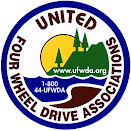United Four Wheel Drive
Associations
· 1701 Westwind Drive #108
· Bakersfield, CA 93301
Website…https://www.facebook.com/united4wd/
FaceBook… https://www.facebook.com/united4wd/
Uphill Traffic Has the Right of Way
By Jerry Smith
Director of Environmental Affairs – United Four Wheel Drive Associations
Some thoughts about “Uphill has the right of way”
The Law
Colorado revised statute. “42-4-711(2) “On narrow mountain highways with turnouts having a grade of six percent or more, ascending vehicles shall have the right-of-way over descending vehicles, except where it is more practicable for the ascending vehicle to return to a turnout."
That this is a law is crazy, but you need to understand lawyers (if that is possible) feel the need to exhibit power over people.”
Why is there a law?
Answer; It is a safety issue.
On any uphill incline on a gravel surface, backing downhill should be your last resort. As you travel backward downhill, the weight of your vehicle shifts toward the rear. Your rear brakes are the secondary brakes on your vehicle—they are designed that way. That is only a small part of this situation though.
The weight transferring to the rear is the major issue. Taking weight off of the front axle reduces the stopping power of your primary brake axle. As you apply more brakes, the front tires will lock and skid on the gravel surface leaving very little stopping ability. For this reason, when backing downhill, you need to keep your speed and momentum very slow and under control.
As you brake under these conditions, there is a tendency for the vehicle to want to turn one way or the other depending on which rear tire has the better traction for the moment. Turning while skidding on a narrow shelf road is NOT recommended. That is why you stay VERY slow while backing.
The Rule/Law
Now, back to the RULE/Law.
When you meet on a hill climb, the first good option is for the downhill traffic to back up to a wide enough place for the uphill traffic to pass SAFELY.
This applies if all things are equal.
When multiple vehicles are traveling together, and they meet fewer vehicles coming from the opposite direction, common sense and courtesy MUST be used.
Avoidance of the Problem
On narrow roads, and ESPECIALLY on steep hills on narrow roads, to lessen this problem in the first place, large groups of vehicles should be spread out so there will be a minimum of 5 or more vehicle lengths between every vehicle.
This way, if the group is stopped (met by opposing traffic), there is a possibility somewhere along the way might be a wide spot that one or more might be able to pull out of the way for others to pass.
There may be times when BOTH directions must give way to the other by having some from each group back to a safe place. This is not a power struggle.
Mental Notes
Wise drivers will make mental notes of where there are wide places as they drive by them for if they need them later. When you are stopped because of on-coming traffic, knowing how far you may need to backup helps when deciding which direction of traffic will be backing up.
The first option is that downhill traffic will back-up. If it makes better sense for the uphill traffic to back down, a good option is for a spotter to be used to guide the backing vehicle(s). Keep the speed very slow and the vehicle(s) very much under control.
Accidents
One other thing needs to be addressed. Under these conditions, it is often necessary to pass the stationary vehicle in extremely close quarters. This is no time to be a bronc buster and blow wildly by. Extreme care must be taken to not trade paint or worse. IF that should happen, the drivers must trade pertinent identification information and insurance contacts. Then, when possible, there should be a report made to the County Sheriff or State Patrol. This is a typical accident report that is required by law. That it happened off-highway is irrelevant.


 e
e